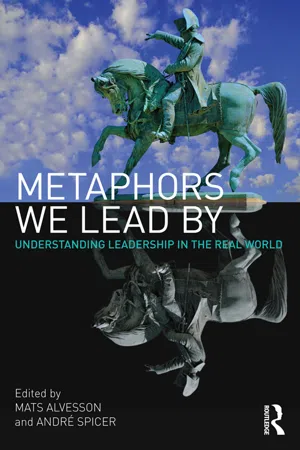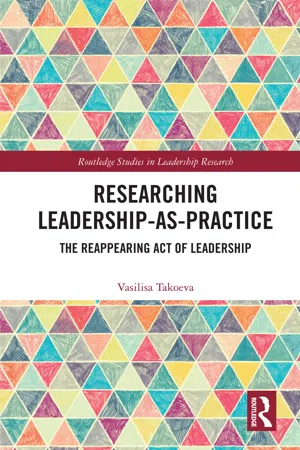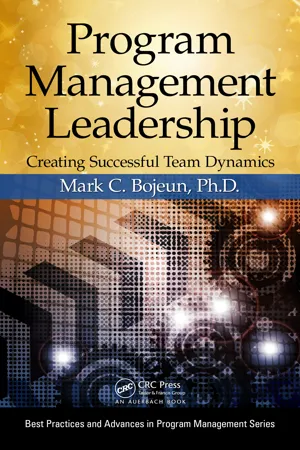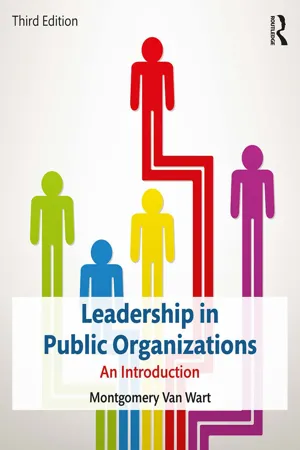Business
Leadership Theories
Leadership theories are frameworks that explain the qualities and behaviors of effective leaders. They provide insight into how leaders emerge, develop, and influence others within an organization. These theories help businesses understand the dynamics of leadership and guide them in developing effective leadership strategies.
Written by Perlego with AI-assistance
Related key terms
Related key terms
1 of 4
Related key terms
1 of 3
11 Key excerpts on "Leadership Theories"
- Patti Chance(Author)
- 2013(Publication Date)
- Routledge(Publisher)
5 Leadership: Influencing Behavior, Relationships, and School EffectivenessSynopsis of Leadership Theories
Leadership Theories attempt to explain the role leaders play in influencing others and the relationship between leadership and organizational effectiveness. Studies of leadership have been approached in a variety of ways with the ultimate goal of identifying variables that impact leadership and affect organizational performance. Historically, research has tended to focus on one aspect of leadership and a limited number of variables, and the resulting Leadership Theories are often categorized according to the researcher’s focus. In this chapter, Leadership Theories are classified into four categories: (a) trait theories of leadership, (b) power approaches to leadership, (c) behaviors of leaders, and (d) transformational, visionary, and moral leadership. Contemporary research on leadership provides more robust theories that frame leadership behaviors within various contexts and demonstrate a number of ways leaders influence organizational processes and systems. This chapter introduces the notion of leadership viewed from the lens of critical theory and explores integrated theories, such as flexible leadership and distributed leadership.Definitions of leadership vary widely, tending to describe leadership in terms of a particular orientation or approach to leadership study. Yukl (1994) proposed that one commonality of the various definitions of leadership is that leadership “involves a social influence process whereby intentional influence is exerted by one person over other people to structure the activities and relationships in a group or organization” (p. 3).In terms of organizational leadership, it is of particular importance to differentiate between leadership and management (or administration). Writers often distinguish these differences by the person (manager versus leader), rather than the process (managing versus leading). For instance, Bennis (1989) stated that “the manager does things right; the leader does the right thing,” and “the manager focuses on systems and structure, the leader focuses on people” (p. 45). However, as Yukl cautioned, stereotypical labeling of people as managers or leaders is too simplistic. Yukl contended that if distinctions should be made, it is between the processes of managing and leading; however, there is no conclusive empirical research that would demonstrate that these processes are mutually exclusive or that they should be performed by different people. Schein (1985) proposed that leadership is distinguished from management in that the principal function of leadership is to shape and direct the organizational culture. Hanson (1996) characterized management as focusing on the “nuts and bolts of making the organization work,” whereas leadership concentrates on strategic vision and skill in drawing followers into actively pursuing the vision (p. 155).- eBook - ePub
- Jonathan Gosling, Ian Sutherland, Stephanie Jones(Authors)
- 2012(Publication Date)
- SAGE Publications Ltd(Publisher)
Current leadership studies have come to focus on the role of followers and group processes, the contextual nature of leadership, and the relationships between leadership and management. Other contemporary theories look at leadership as a dynamic process involving many individuals rather than seeing leadership emanating solely from a single person, and include perspectives on ‘distributed leadership’, ‘quiet leadership’, ‘soft leadership’, ‘authentic leadership’, ‘aesthetic leadership’, ‘narcissistic leadership’, ‘spiritual leadership’ and ‘toxic leadership’. Modern leadership studies view leadership as a dynamic, subtle, nuanced process emerging from the actions of groups of people – leaders and followers alike – working together to achieve common goals, in group and inter-group relationships. Some also point to the contrast between ‘formal’ and ‘informal’ leadership, with its connotations of authority and participation (House and Baetz, 1979). (See the summary in Table 1). Table 1 Summary of popular Leadership Theories over time Great Man Theories Based on the belief that leaders are exceptional people, born with innate qualities, destined to lead. The use of the term ‘man’ was an unquestioned assumption until the late twentieth century, as leadership was primarily male and usually military. Few people bothered to look for examples of leadership outside these categories. Trait Theories Trait theories studied successful leaders and moments of leadership to identify traits or qualities which appeared essential to leadership practice. These included adjectives describing mostly positive human behaviours, from A for ambition to Z for zest for life. Maturity, confidence, breadth of interest, intelligence and honesty were qualities common across much of the trait theory research. Traits were seen as characteristics of the person. More recently, interest has shifted towards descriptions of what people can actually do, regardless of personality - eBook - ePub
Metaphors We Lead By
Understanding Leadership in the Real World
- Mats Alvesson, André Spicer, Mats Alvesson, André Spicer(Authors)
- 2010(Publication Date)
- Routledge(Publisher)
Chapter 2 THEORIES OF LEADERSHIPMats Alvesson and André SpicerINTRODUCTION
WE ARE OFTEN TOLD THAT leadership is the vital ingredient in any successful organization. It is what distinguishes thriving organizations from languishing ones. The presumed importance of leadership fuels many corporations’ obsession with encouraging their employees to become leaders. Many people think that perennial organizational problems such increasing productivity, ensuring quality, driving innovation, building morale and delivering strategies can all be dealt with through more and better leadership. When things go wrong, one of the first things that a board of directors does is look for new leadership. Even organizations that traditionally downplayed leadership now ascribe more and more significance to it. Today schools, hospitals and universities routinely try to encourage leadership in their ranks.Given our confidence in leadership, we might assume it would have a clear and distinct meaning. Sadly, this is not the case. A quick look at some of the academic texts on leadership reminds us there is a very broad spectrum of definitions. Yukl (1989: 253) points out that ‘the numerous definitions of leadership that have been proposed appear to have little else in common’ than involving an influence process. Yukl himself tried to bring a little order to this complicated field by defining leadership as ‘influencing task objectives and strategies, influencing commitment and compliance in task behaviour to achieve these objectives, influencing group maintenance and identification, and influencing the culture of an organization’ (p. 253). This definition makes sense but it does not to say that much. Leadership is about influencing a range of things. It seems that even the best definitions of leadership are often so broad and ambiguous that they are of limited value and sometimes become fairly meaningless. It is difficult to establish cognitive control over concepts like leadership (and many other concepts as well, but leadership may still be one of the trickiest). It works more through the associations it ignites. - No longer available |Learn more
Studying Leadership
Traditional and Critical Approaches
- Doris Schedlitzki, Gareth Edwards(Authors)
- 2017(Publication Date)
- SAGE Publications Ltd(Publisher)
More specifically, implicit leadership theory helps us to explain and understand how an individual’s values, experiences and thoughts form cognitive models that determine his/her view on who a leader is and what makes effective leadership. Moving to a group level of analysis, we highlight insights gained through social identity theory on how values and beliefs held within social groups further influence perceptions of effective leadership. After exploring the limitations of this psychological perspective on capturing the fluid, interactional nature of leadership, we then move on to introduce the notion of social constructionism as it is rooted in a sociologically informed and European-based research tradition, and finally conclude by introducing critically focused approaches to our understanding of leadership context. Other notions of context such as culture, gender and diversity will be picked up further in Chapters 9 and 12. Critical Thinking Box 5.1 As highlighted in Chapter 3, the majority of Leadership Theories of the 20th century were based on research conducted in a US context and focused on the individual leader and engagement with individual followers. This focus has silenced other cultural and organisational contexts as well as failed to explore in detail what the leadership context is, how different contextual factors interplay, and affect and are affected by leadership. Recognising this void of dynamic investigations of leadership context, Evans and Sinclair (2016) demonstrate the complex, changing nature of culturally specific notions of leadership amongst Australian Indigenous arts leaders. This shows not only that their perspective on leadership is different from the US-centric views embedded in mainstream Leadership Theories such as presented in Chapters 3 and 4, but that there are a multitude of different perceptions of what makes effective leadership throughout society and across different generations - eBook - ePub
Developing Skills for Business Leadership
Building Personal Effectiveness and Business Acumen
- Gillian Watson, Stefanie Reissner(Authors)
- 2023(Publication Date)
- CIPD - Kogan Page(Publisher)
09Perspectives on leadership in organisations
Introduction
Leadership is widely regarded as a managerial activity that leads to organisational success, having been defined as ‘the process of influencing others to understand and agree about what needs to be done and how to do it, and the process of facilitating individual and collective efforts to accomplishing shared objectives’ (Yukl, 2010: 26). As such, leadership tends to be associated with those at the very top of an organisation’s hierarchy, although, as we will see in this chapter, leadership can be practised in different ways at different hierarchical layers across an organisation and beyond. It is therefore important for all of you.However, being an organisational leader can be difficult as people may wish to exercise influence themselves, rather than be influenced by others, bringing into play complex interpersonal dynamics, such as relationships, trust, authority, etc. There have been intense debates about if leaders can be appointed, or if it is rather that ‘followers’ (whoever they may be) ‘make’ leaders through their followership. It needs to be recognised that not all leaders always have the right attributes, behaviours, capabilities, skills and what is generally known as leadership style to be effective in influencing others and directing the organisation’s fortunes. The COVID-19 pandemic has further highlighted the difficulties associated with leading at spatio-temporal distance in which there are limited opportunities for in-person interactions, with virtually mediated interactions offering but a poor substitute (see Chapter 7 ).In this chapter, we will explore the complex concept of leadership and the associated practices in an organisational context. Specifically, we will examine what leadership is and how it is related to management, given that the two terms are sometimes used interchangeably, and that one person may undertake both leadership and management tasks as part of their role. We will then consider some of the seminal theories through which scholars and practitioners have sought to understand the concept of leadership, followed by a critical examination of the implications that these theories have for both the practice of leadership in organisations and the development of future leaders. At the end of the chapter, we will discuss additional complexity that comes with leading internationally, which is what we expect many of you to be involved in as part of your current or future roles. - eBook - ePub
Researching Leadership-As-Practice
The Reappearing Act of Leadership
- Vasilisa Takoeva(Author)
- 2021(Publication Date)
- Routledge(Publisher)
The leader is the sole Agent of activity, who uses her/his personal characteristics, skills and behaviours as Tools for motivating and directing the followers towards a shared goal. The followers are mere recipients of the leader’s actions and therefore belong to the Situated Community, beyond the immediate focus of research. The assumption around unidirectional interactions is represented in the Roles and Responsibilities element, whereas the Long-Term Goal would be normally phrased as an achievement of some objective that causes a specific change within an otherwise stable organisation. As stated in Chapter 2, this view of leadership emerged within the context of relatively steady industrial operations, clearer objectives and assumptions of a straightforward assessment of leadership outcomes. Although over time most elements and linking arrows of this system were included in consideration, the research itself has a tendency to focus on the leader and his/her actions or on the upper visible part of the triangle. The trait theories look primarily at the Agents (leaders) and the Tools and Concepts (traits and other personal characteristics). The behavioural leadership theory included into the scope of analysis the link with followers (Situated Community) and the behavioural styles (Roles and Responsibilities). The situational and contingency theories expanded the focus further and drew some attention to the Underlying Assumptions and Roles and Responsibilities elements through making explicit assumptions about followers’ stage of development and requirements. The macro-economic changes to business dynamics and challenges led to a slight change in this perspective with transformational and charismatic leadership representations (Figure 6.2) - eBook - ePub
Program Management Leadership
Creating Successful Team Dynamics
- Mark C. Bojeun(Author)
- 2013(Publication Date)
- Auerbach Publications(Publisher)
9 Leadership Theories“A leader has to appear consistent. That doesn’t mean he has to be consistent.”—James CallahanTo understand the effect the leadership style of a program manager can have on a program team, it is first necessary to understand various leadership styles. Each of the styles discussed here, although not a comprehensive list, has positive and negative qualities, and no single style will be effective in all scenarios.Many Leadership Theories have evolved over the last 100 years ranging from great man, leadership traits, and behavioral to transformational, transactional, dark versus light, situational, and charismatic. Researchers have made efforts to link some of the theories across these leadership islands. Each model has its own pros, cons, assumptions, and limitations, but current research is much more focused on situational and transformational leadership styles, while the ongoing debate between born versus made leaders continues. Leadership gurus continue to offer new models as variations to many already existing models. Max Weber, MacGregor Burns, Bernard Bass, and Warren Bennis are a few of the important researchers in the area of leadership. Understanding the variances between leadership styles and traits is vital to leveraging the leadership theory in the workplace.Leadership Theories have an extensive history and abound with research and supporting materials. Leadership contributes to the development and innovation of new products, increased services through better communication, empowering staff, and discourse on risky issues (Howell and Higgins 1990). Although the general value of leadership is well accepted, the preferred style of leadership for specific scenarios is debated. Whether transformational versus transactional, charismatic versus pseudo-transformational, situational versus servant, or authoritative versus collaborative, leadership style has a tremendous impact on a team and its ability to perform effectively, positively, and innovatively in the attempt to meet or exceed business goals. With so many different leadership styles, which one is the best for program management and team empowerment in simple or highly complex environments? The answer, of course, is it depends... - eBook - ePub
Leadership in Public Organizations
An Introduction
- Montgomery Van Wart, Paul Suino, Montgomery Van Wart(Authors)
- 2017(Publication Date)
- Routledge(Publisher)
Leadership is a complex phenomenon, so it is unlikely that any single theory will ever adequately explain all of its aspects for the many different purposes that theories fulfill (explanation, evaluation, training, etc.). To help with the task, a causal-chain model was presented as a useful tool to compare the different types of theories that are popular. In this model, leader styles are the independent variable and performance is the dependent variable. However, various contingencies affect the best style to use (intervening variables), and the effectiveness of style execution (moderating variables) is also important. First, two early perspectives were reviewed. Classical management largely assumes a “one-best-style”: directive leadership. Trait theory largely assumes a combined style as a composite of an ideal set of traits, but this approach leaves too many elements and variables unexplained. Stemming from the acknowledgment of different roles in large organizations, another common approach has been to divide leadership responsibilities according to the stratified systems that typify most traditional organizations (thus they are a type of situational approach). Transactional approaches also pay more attention to the leadership situation than did trait or classical management approaches—either worker needs and/or contingencies. Blake and Mouton’s managerial grid assumes an ideal balance of task and support in a universalist approach. Hersey and Blanchard focus on followers’ development needs, varying the style according to the followers’ maturity. House and his colleagues in path-goal theory include not only followers’ needs but also task and organizational needs. This means that the calculus for deciding exactly what type of leadership style is necessary can become quite sophisticated, although in his 1974 model House proposes only four major styles - eBook - ePub
Leadership in Libraries
A Focus on Ethnic-Minority Librarians
- Maha Kumaran(Author)
- 2012(Publication Date)
- Chandos Publishing(Publisher)
3Leadership styles
Abstract:
Leadership Theories such as trait theory, behavioral theory, and contingency theory are well known. Each of these theories, developed at various times during the 20th century, focuses on various styles for leaders. While the Great Man theory believed in leaders being born as leaders, other theories implied that leaders need to focus on styles and skills that will turn them into true leaders.Key words leadership styles Great Man theory trait theory behavioral theory situational theory female leadership stylesSpeaking in S. R. Ranganathan’s style:Every leader his or her style.Every leader his or her set of skills.Every leader his or her organization.Every leader his or her strengths and weaknesses.Every leader his or her opportunity.As already mentioned, leadership is about influencing, mobilizing, motivating, inspiring, and enabling everyone to achieve their fullest potential. Persuading and motivating an organization are not easy tasks to accomplish. To do this effectively, leaders are expected to learn and practice, or at least be aware of, different styles and skills that they can use in different situations.A leader with no leadership style, or with an inflexible leadership style, will not be successful in helping anyone achieve their fullest potential, and as a result will not be successful in leading the organization. Depending on the organizational culture and the expectations from the kind of audience one is leading, a leader may adopt a style that is authoritative, autocratic, participative, democratic, or delegative.What is leadership style?
Style is the way in which a leader acts. It is the way in which the leader behaves while motivating, influencing, and accomplishing. Style can either be physiological as in body language, voice, eye contact, and words used, or characteristic as in showing humility, or intellective as in being intelligent or an intellectual. Style can be tangible or intangible. The style that a leader uses will depend on the individual’s values, beliefs, cultural background, organizational background, and personal preferences. Just as it is difficult to offer one definition for leadership, so too is it difficult to define what styles a good leader should possess. - eBook - ePub
Essential Leadership
Develop Your Leadership Qualities Through Theory and Practice
- Esther Cameron, Mike Green(Authors)
- 2017(Publication Date)
- Kogan Page(Publisher)
4 on Contingency Theories and Situational Leadership, which set out theories and frameworks exploring how different types of leaders succeed in different contexts. The powerful idea that leaders can adapt their behaviour according to the situation is also introduced and discussed.Chapter 5 on Psychodynamics, Power and the Shadow looks at parallel developments in the areas of psychodynamics, personality and the source of power, and explains how this work can support leaders. Approaches to understanding personality and the dynamics between individuals are identified. We also look at how power and politics arise and the ways in which these can be used well, or lead to unhealthy interpersonal and organizational dynamics. We explain some of the phenomena of the shadow or dark side of leadership too.The question of motivation, inspiration and ‘moral development’ is explored in Chapter 6 , which focuses on Transformational and Transactional Leadership. This chapter describes the history and evolution of this framework, sets out some of the research that has been done to explore this approach to leadership, and looks at what the critics say about the shortcomings of some applications of this framework.Chapters 7 –11 look at a wider range of perspectives from the 1990s onwards. Chapter 7 on Strategic and Innovation Leadership sets out the most important development in ideas around strategic thinking, creativity and innovation from a leadership perspective by exploring the work of Schoemaker, Mintzberg and Bossink amongst others. Chapter 8 explores the wider topic of Change Leadership, setting out the evolution of theory and frameworks in this complex and important area of leadership. We refer to Kotter, Bennis, Schein and Heifetz in particular.The challenges of leading ethically and responsibly are explored in Chapter 9 - Maureen Rhoden, Brian Cato(Authors)
- 2017(Publication Date)
- Wiley-Blackwell(Publisher)
The assumption here is that leaders can be made and that successful leadership is based in definable, learnable behaviour. The behavioural theories look beyond the inborn traits or capabilities to what the leaders actually do. In order to become a good leader, the next generation of leaders can copy what previous leaders have done. The converse of this is that the external environment, politically, economically, technologically, and so on is continuing to evolve and so in theory so should the roles and behaviours of good leaders (Fleishman, 1953; Bowers and Seashore, 1966).Participative leadership
This theory assumes that the leader can improve the decision making process by actually being involved in the processes and hence this gained knowledge makes for a better outcome in the decision made. It also builds on the idea that people will be more likely to follow a leader who shows actions with which they could relate. This can also be described as social leadership. It is generally perceived that politicians are somewhat removed from social issues, such as monetary or sanitary pressures, despite making wide ranging policies dealing with these issues. This style is seen as a step away from the autocratic process, as there is some involvement from other areas, however the leader can decide to either incorporate or ignore the influences from their participation (Rollinson, 2008).A main advocate of this study was Kurt Lewin (1940s), who initially identified three main styles: Autocratic, Democratic and Laissez‐faire. Running alongside this theory was the study done by Rensis Likert (1987), who broke the participative leadership into four main styles: Exploitive authoritative, Benevolent authoritative, Consultative and Participative.Situational leadership
These theories identify that the best action and style for a leader will vary depending upon a range of situational factors. These theories suggest that each decision needed should not simply be tackled based upon a certain style that has worked in the past but other subtle factors such as the capability of the team members, the level of motivation and energy within the team and so on at the time the decision is required should have an influence on the final decision.
Index pages curate the most relevant extracts from our library of academic textbooks. They’ve been created using an in-house natural language model (NLM), each adding context and meaning to key research topics.
Explore more topic indexes
Explore more topic indexes
1 of 6
Explore more topic indexes
1 of 4










